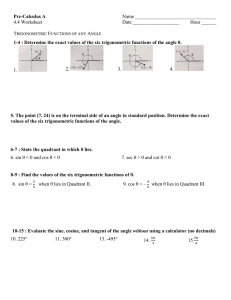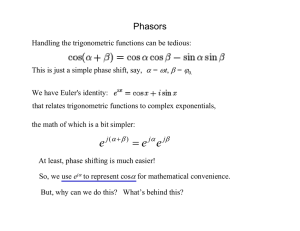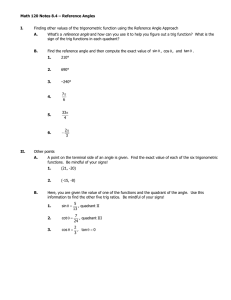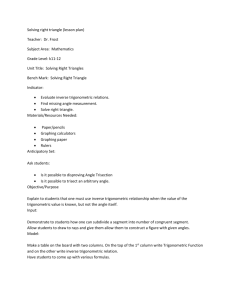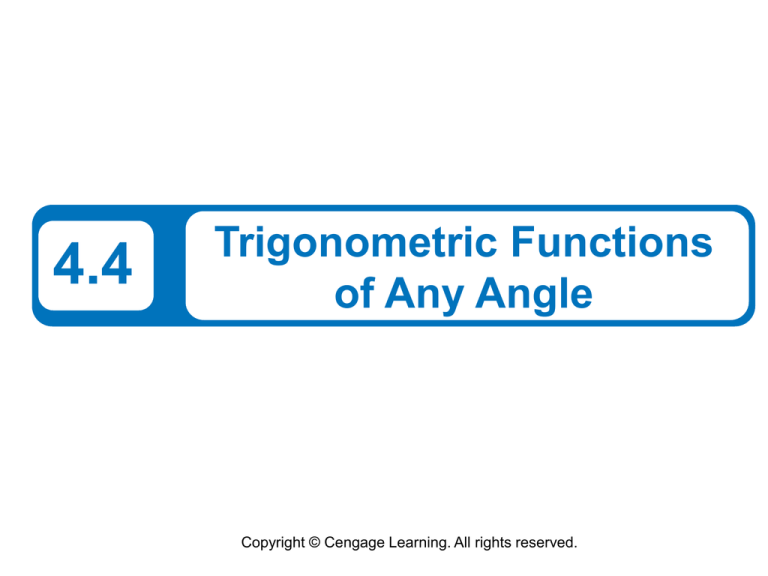
4.4
Trigonometric Functions
of Any Angle
Copyright © Cengage Learning. All rights reserved.
What You Should Learn
•
Evaluate trigonometric functions of any angle
•
Find reference angles
•
Evaluate trigonometric functions of real
numbers
2
Introduction
3
Introduction
Following is the definition of trigonometric functions of Any
Angle. This applies when the radius is not one (not a unit
circle).
4
Introduction
Note: when x = 0, the tangent and secant of are
undefined.
For example, the tangent of 90 is undefined since the sine
of 90 is 1 and the cosine of 90 is 0. 1/0 is undefined.
Similarly, when y = 0, the cotangent and cosecant of are
undefined.
5
Example 1 – Evaluating Trigonometric Functions
Let (–3, 4) be a point on the terminal side of
(see Figure 4.34).
Find the sine, cosine, and tangent of .
Figure 4.34
6
Example 1 – Solution
Referring to Figure 4.34, you can see by using the
Pythagorean Theorem and the given point that x = –3, y =
4, and
7
Example 1 – Solution
cont’d
So, you have
and
8
Introduction
The signs of the trigonometric functions in the four
quadrants can be determined easily from the definitions of
the functions. For instance, because
it follows that cos is positive
wherever x > 0, which is in
Quadrants I and IV.
We will discuss “All Students
Take Calculus” in class as a way
to help us remember this.
9
Reference Angles
10
Reference Angles
The values of the trigonometric functions of angles greater
than 90 (or less than 0) can be determined from their
values at corresponding acute angles called reference
angles.
11
Reference Angles
Figure 4.37 shows the reference angles for in Quadrants
II, III, and IV.
Figure 4.37
12
Example 4 – Finding Reference Angles
Find the reference angle .
a. = 300
b. = 2.3
c. = –135
Solution:
a. Because 300 lies in Quadrant IV, the angle it makes
with the x-axis is
= 360 – 300
Degrees
= 60.
13
Example 4 – Solution
cont’d
b. Because 2.3 lies between /2 1.5708 and 3.1416,
it follows that it is in Quadrant II and its reference angle
is
= – 2.3
Radians
0.8416.
c. First, determine that –135 is coterminal with 225,
which lies in Quadrant III. So, the reference angle is
= 225 – 180
Degrees
= 45.
14
Example 4 – Solution
cont’d
Figure 4.38 shows each angle and its reference angle .
(a)
(b)
(c)
Figure 4.38
15
Trigonometric Functions of Real Numbers
16
Trigonometric Functions of Real Numbers
To see how a reference angle is used to evaluate a
trigonometric function, consider the point (x, y) on the
terminal side of , as shown in Figure 4.39.
Figure 4.39
17
Trigonometric Functions of Real Numbers
By definition, you know that
and
For the right triangle with acute angle and sides of
lengths |x| and |y|, you have
and
18
Trigonometric Functions of Real Numbers
So, it follows that sin and sin are equal, except
possibly in sign. The same is true for tan and tan and
for the other four trigonometric functions. In all cases, the
sign of the function value can be determined by the
quadrant in which lies.
19
Example 5 – Trigonometric Functions of Nonacute Angles
Evaluate each trigonometric function.
a.
b. tan = (–210)
c.
Solution:
a. Because = 4 /3 lies in Quadrant III, the
reference angle is = (4 /3) – = /3,
as shown in Figure 4.40.
Moreover, the cosine is negative in
Quadrant III, so
Figure 4.40
20
Example 5 – Solution
cont’d
b. Because –210 + 360 = 150, it follows that –210 is
coterminal with the second-quadrant angle 150.
Therefore, the reference angle is = 180 – 150 = 30,
as shown in Figure 4.41.
Finally, because the tangent is
negative in Quadrant II, you have.
Figure 4.41
21
Example 5 – Solution
cont’d
c. Because (11 /4) – 2 = 3 /4, it follows that 11 /4 is
coterminal with the second-quadrant angle 3/4.
Therefore, the reference angle is = – (3 /4) = /4,
as shown in Figure 4.42.
Because the cosecant is positive
in Quadrant II, you have
Figure 4.42
22

